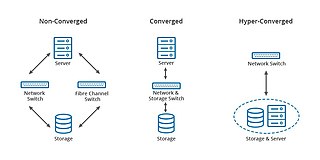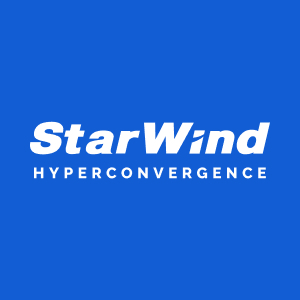Related Research Articles
Internet Small Computer Systems Interface or iSCSI is an Internet Protocol-based storage networking standard for linking data storage facilities. iSCSI provides block-level access to storage devices by carrying SCSI commands over a TCP/IP network. iSCSI facilitates data transfers over intranets and to manage storage over long distances. It can be used to transmit data over local area networks (LANs), wide area networks (WANs), or the Internet and can enable location-independent data storage and retrieval.
In computing, paravirtualization or para-virtualization is a virtualization technique that presents a software interface to the virtual machines which is similar, yet not identical, to the underlying hardware–software interface.
A virtual storage area network is a logical representation of a physical storage area network (SAN). A VSAN abstracts the storage-related operations from the physical storage layer, and provides shared storage access to the applications and virtual machines by combining the servers' local storage over a network into a single or multiple storage pools.
In computer science, storage virtualization is "the process of presenting a logical view of the physical storage resources to" a host computer system, "treating all storage media in the enterprise as a single pool of storage."
Desktop virtualization is a software technology that separates the desktop environment and associated application software from the physical client device that is used to access it.

VMware ESXi is an enterprise-class, type-1 hypervisor developed by VMware, a subsidiary of Broadcom, for deploying and serving virtual computers. As a type-1 hypervisor, ESXi is not a software application that is installed on an operating system (OS); instead, it includes and integrates vital OS components, such as a kernel.
Virtual Iron Software, was located in Lowell, Massachusetts, sold proprietary software for virtualization and management of a virtual infrastructure. Co-founded by Alex Vasilevsky, Virtual Iron figured among the first companies to offer virtualization software to fully support Intel VT-x and AMD-V hardware-assisted virtualization.
Hardware virtualization is the virtualization of computers as complete hardware platforms, certain logical abstractions of their componentry, or only the functionality required to run various operating systems. Virtualization hides the physical characteristics of a computing platform from the users, presenting instead an abstract computing platform. At its origins, the software that controlled virtualization was called a "control program", but the terms "hypervisor" or "virtual machine monitor" became preferred over time.
Infrastructure as a service (IaaS) is a cloud computing service model by means of which computing resources are supplied by a cloud services provider. The IaaS vendor provides the storage, network, servers, and virtualization. This service enables users to free themselves from maintaining an on-premises data center. The IaaS provider is hosting these resources in either the public cloud, the private cloud, or the hybrid cloud.

oVirt is a free, open-source virtualization management platform. It was founded by Red Hat as a community project on which Red Hat Virtualization is based. It allows centralized management of virtual machines, compute, storage and networking resources, from an easy-to-use web-based front-end with platform independent access. KVM on x86-64, PowerPC64 and s390x architecture are the only hypervisors supported, but there is an ongoing effort to support ARM architecture in a future releases.
In computing, virtualization or virtualisation in British English is the act of creating a virtual version of something at the same abstraction level, including virtual computer hardware platforms, storage devices, and computer network resources.
In computer science, memory virtualization decouples volatile random access memory (RAM) resources from individual systems in the data centre, and then aggregates those resources into a virtualized memory pool available to any computer in the cluster. The memory pool is accessed by the operating system or applications running on top of the operating system. The distributed memory pool can then be utilized as a high-speed cache, a messaging layer, or a large, shared memory resource for a CPU or a GPU application.

OpenNebula is an open source cloud computing platform for managing heterogeneous data center, public cloud and edge computing infrastructure resources. OpenNebula manages on-premises and remote virtual infrastructure to build private, public, or hybrid implementations of Infrastructure as a Service and multi-tenant Kubernetes deployments. The two primary uses of the OpenNebula platform are data center virtualization and cloud deployments based on the KVM hypervisor, LXD/LXC system containers, and AWS Firecracker microVMs. The platform is also capable of offering the cloud infrastructure necessary to operate a cloud on top of existing VMware infrastructure. In early June 2020, OpenNebula announced the release of a new Enterprise Edition for corporate users, along with a Community Edition. OpenNebula CE is free and open-source software, released under the Apache License version 2. OpenNebula CE comes with free access to patch releases containing critical bug fixes but with no access to the regular EE maintenance releases. Upgrades to the latest minor/major version is only available for CE users with non-commercial deployments or with significant open source contributions to the OpenNebula Community. OpenNebula EE is distributed under a closed-source license and requires a commercial Subscription.

Converged storage is a storage architecture that combines storage and computing resources into a single entity. This can result in the development of platforms for server centric, storage centric or hybrid workloads where applications and data come together to improve application performance and delivery. The combination of storage and compute differs to the traditional IT model in which computation and storage take place in separate or siloed computer equipment. The traditional model requires discrete provisioning changes, such as upgrades and planned migrations, in the face of server load changes, which are increasingly dynamic with virtualization, where converged storage increases the supply of resources along with new VM demands in parallel.

StarWind Software, Inc. is a privately held Beverly, Massachusetts-based computer software and hardware appliance company specializing in storage virtualization and software-defined storage.
VM-aware storage (VAS) is computer data storage designed specifically for managing storage for virtual machines (VMs) within a data center. The goal is to provide storage that is simpler to use with functionality better suited for VMs compared with general-purpose storage. VM-aware storage allows storage to be managed as an integrated part of managing VMs rather than as logical unit numbers (LUNs) or volumes that are separately configured and managed.
Software-defined data center is a marketing term that extends virtualization concepts such as abstraction, pooling, and automation to all data center resources and services to achieve IT as a service (ITaaS). In a software-defined data center, "all elements of the infrastructure — networking, storage, CPU and security – are virtualized and delivered as a service."
ViPR Controller is a software-defined storage offering from EMC Corporation announced on May 6, 2013, at EMC World. ViPR abstracts storage from disparate arrays into a single pool of storage capacity that "makes it easier to manage and automate its own data-storage devices and those made by competitors." ViPR became generally available September 27, 2013.

Dell Technologies PowerFlex, is a commercial software-defined storage product from Dell Technologies that creates a server-based storage area network (SAN) from local server storage using x86 servers. It converts this direct-attached storage into shared block storage that runs over an IP-based network.

Hyper-converged infrastructure (HCI) is a software-defined IT infrastructure that virtualizes all of the elements of conventional "hardware-defined" systems. HCI includes, at a minimum, virtualized computing, software-defined storage, and virtualized networking. HCI typically runs on commercial off-the-shelf (COTS) servers.
References
- ↑ Margaret Rouse. "Definition: software-defined storage". SearchSDN. Tech Target. Retrieved November 7, 2013.
- ↑ Chris Poelker (March 12, 2014). "The foundation of clouds: Intelligent abstraction".
- ↑ SNIA (March 2014). "Technical Whitepaper:Software Defined Storage".
- ↑ Archana Venkatraman. "Software-defined datacentres demystified". Computer Weekly . TechTarget . Retrieved November 7, 2013.
The term software-defined datacentre (SDDC) rose to prominence this year during annual virtualisation conference VMworld 2012 [...] A software-defined datacentre is an IT facility where the elements of the infrastructure - networking, storage, CPU and security - are virtualised and delivered as a service. The provisioning and operation of the entire infrastructure is entirely automated by software.
- ↑ "The Software-Defined Data Center". company web site. VMware. Retrieved November 7, 2013.
- ↑ Margaret Rouse. "Definition: software-defined storage". SearchSDN. Tech Target. Retrieved November 7, 2013.
- ↑ "Technology Focus Areas | SNIA".
- ↑ "Thriving software-defined-storage market will ramp up to $86B by 2023: report". FierceTelecom. 20 March 2020. Retrieved 2020-03-23.
- ↑ "第二期观点|天翼云存储资源盘活系统 HBlock,全面释放企业数据价值_云计算_InfoQ精选文章". www.infoq.cn. Retrieved 2024-04-16.
- ↑ Simon Robinson (March 12, 2013). "Software-defined storage: The reality beneath the hype". Computer Weekly. Retrieved November 7, 2013.
- ↑ "Comparison of virtualization technologies".
- ↑ Snyder, Brett; Ringenberg, Jordan; Green, Robert; Devabhaktuni, Vijay; Alam, Mansoor (June 9, 2014). "Evaluation and design of highly reliable and highly utilized cloud computing systems". Journal of Cloud Computing. 4: 12. doi: 10.1186/s13677-015-0036-6 . S2CID 17909593.
- ↑ "Hypervisor glossary definition" (PDF). Xen v2.0 for x86 Users' Manual (PDF). Xen.org on August 20, 2011. Archived from the original (PDF) on October 5, 2011. Retrieved October 4, 2017.
- ↑ "SearchStorage.com definition". What is storage virtualization? Definition on SearchStorage.com.
- ↑ IBM SmartCloud Virtual Storage Center. IBM Redbooks. 6 March 2015. ISBN 9780738440439.
- ↑ Erickson, Todd (June 23, 2011). "SearchDisasterRecovery Article". SearchDisasterRecovery.com. Archived from the original on October 4, 2017. Retrieved October 4, 2017.
- ↑ Mearian, Lucas (November 23, 2010). "ComputerWorld Article". Archived from the original on October 4, 2017. Retrieved October 4, 2017.